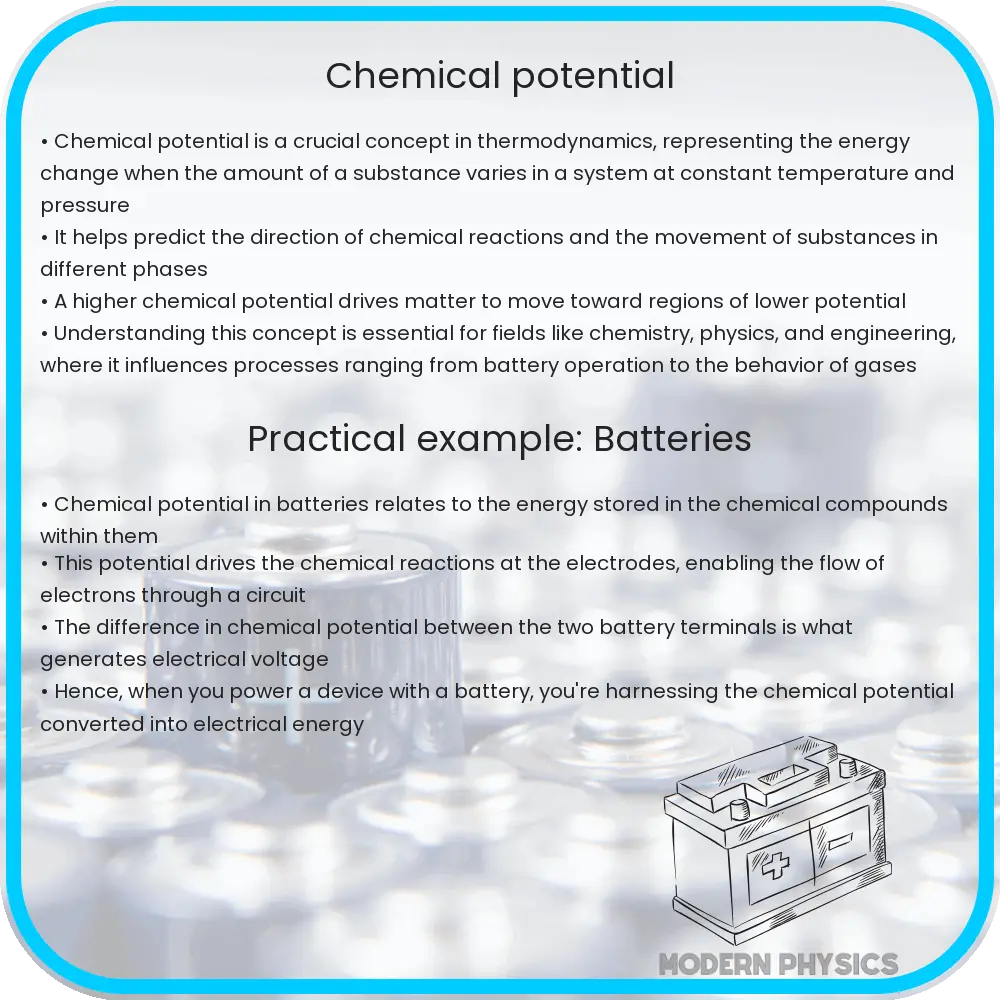Explore the role of chemical potential in thermodynamics and chemistry, from reactions and equilibrium to environmental and electrochemical applications.

Understanding Chemical Potential: Its Theory, Applications, and Role in Equilibrium
Chemical potential, a fundamental concept in thermodynamics and chemistry, plays a crucial role in understanding the behavior of substances in various states and conditions. It’s a measure of the potential energy of a substance’s molecules or atoms, influencing how substances interact, mix, and react with each other.
Theoretical Foundations of Chemical Potential
The concept of chemical potential was introduced to describe the energy change associated with the addition or removal of a particle from a system. It’s denoted by the Greek letter μ and is defined as the derivative of the Gibbs free energy (G) with respect to the number of particles (N) at constant temperature (T) and pressure (P):
μ = (∂G/∂N)T,P
This relationship underscores the importance of chemical potential in predicting the direction of chemical reactions and phase changes.
Applications in Chemical Reactions and Equilibrium
In the context of chemical reactions, the chemical potential helps in understanding the direction in which a reaction will proceed. A reaction moves towards equilibrium when the chemical potential of the reactants and products becomes equal. For example, in the reaction:
A + B → C + D
The equilibrium condition can be expressed as:
μA + μB = μC + μD
This equation indicates that at equilibrium, the sum of the chemical potentials of the reactants equals that of the products.
Role in Phase Equilibria
Chemical potential is equally vital in understanding phase equilibria, the balance between different phases of a substance like solid, liquid, and gas. At equilibrium, the chemical potential of a substance in different phases is equal. For instance, in the equilibrium between liquid water and water vapor, the chemical potential of water in both phases is the same.
Overall, the concept of chemical potential is integral to predicting and explaining the behavior of substances in a wide range of chemical and physical processes. Its application extends from simple phase changes to complex chemical reactions, offering a deeper insight into the fundamentals of matter and its transformations.
Chemical Potential in Electrochemical Processes
Chemical potential finds significant application in electrochemistry, particularly in batteries and fuel cells. In these systems, the movement of electrons and ions is driven by differences in chemical potential, leading to the generation of electrical energy. For example, in a lithium-ion battery, the chemical potential difference between the anode and cathode drives the flow of electrons through an external circuit, powering electronic devices.
Influence on Diffusion and Osmosis
Diffusion, the movement of particles from a region of high concentration to low concentration, is also governed by chemical potential. Particles move in a direction that leads to the equalization of their chemical potential throughout the system. Similarly, osmosis, the movement of solvent molecules through a semipermeable membrane, occurs due to differences in chemical potential on either side of the membrane. This principle is crucial in biological processes and industrial applications like desalination.
Chemical Potential in Environmental Systems
Understanding chemical potential is essential in environmental chemistry, especially in pollutant migration and the behavior of contaminants in ecosystems. For instance, the spread of pollutants in water bodies or soil can be analyzed through the lens of chemical potential, aiding in the development of more effective remediation strategies.
Conclusion
The concept of chemical potential is a cornerstone in the study of chemistry and thermodynamics. Its profound impact is observed in a myriad of processes, from the intricate reactions in living organisms to the large-scale industrial applications. Whether it’s facilitating the understanding of chemical reactions and phase equilibria, driving the mechanisms in batteries and fuel cells, or guiding the principles of diffusion and osmosis, chemical potential remains a key player. Moreover, its relevance in environmental chemistry underscores its importance in addressing contemporary challenges. As a fundamental concept, chemical potential not only elucidates the behavior of matter but also bridges the gap between theoretical chemistry and practical applications, highlighting the interconnectedness of scientific principles and real-world phenomena.
